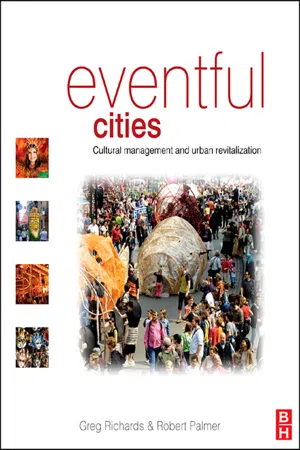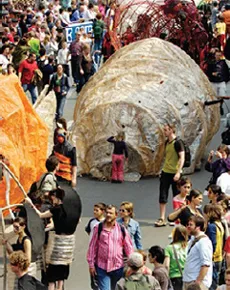![]()
| |
Why Cities
Need to be Eventful |
In recent years, culture has taken on a more instrumental meaning in cities. It now represents the ideas and practices, sites and symbols, of what has been called the ‘symbolic economy’, i.e., the process through which wealth is created from cultural activities, including art, music, dance, crafts, museums, exhibitions, sports and creative design in various fields. This new concept of culture increasingly shapes city strategies in the face of both global competition and local tensions.
(Zukin, 2004:3)
Festivals influence people’s idea of a city. They provide many points of identification and contribute to the birth of non-mainstream urban identities. They consolidate subcultures and create togetherness among amateurs of a common field. At their best festivals culminate in a ‘festival moment’, creating a momentum born of dramaturgical excellence and high quality content, a powerful experience bringing together audience and festival performers and organisers.
(Silvanto & Hellman, 2005:6)
THE DESIRE FOR EVENTFULNESS
Cities of today face two choices. Either they develop to meet the challenges created by the pace of global change, or they resist the impulse for transformation and stagnate. At a time when economic systems are no longer predictable, in order to remain competitive, cities are turning to strategies that focus on their own innate resources - their histories, spaces, creative energy and talents. Pressures of globalisation and problems caused by economic restructuring, as well as the need to establish new civic identities, have prompted cities to utilise ‘cultural’ assets and resources in an attempt to become distinctive, to regenerate the urban fabric and to create economic, social and cultural prosperity. The creation and promotion of events such as festivals, shows, exhibitions, fairs and championships, have become a critical component of urban development strategy across the globe. No city believes it is too small or too complex to enter the market of planning and producing events.
Entire cities have transformed themselves into major stages for a continual stream of events, which can lead eventually to a ‘festivalisation’ of the city. With the growth of the ‘symbolic economy’ (Lash & Urry, 1994; Zukin, 1995) and the ‘experience economy’ (Pine & Gilmore, 1999), culture has become an increasingly important means of consuming the city (Ritzer, 1999). The growing prominence of events has led some cities to promote themselves as ‘eventful cities’. Melbourne labels itself as ‘the world’s event city’ (2008), and Seoul claims to be ‘one of the most eventful cities of the world’ (2006), while at the same time the Hong Kong Government (2006) has also been ‘working to make Hong Kong one of the most eventful cities in the world’. Other cities make slightly less global claims, but focus on their competitive place in an increasingly crowded market for national events, such as Nevada’s Reno-Tahoe Territory (2006) that profiles itself as the ‘Most Eventful City in America’. Durban claims it is ‘Africa’s premier sporting and events destination’ (Mlaba, 2009). Cities that have not yet become eventful are also making efforts to enter or reinforce their place in the urban events market, with initiatives such as the ‘Singapore Roars! Roadshow’ organised by the Singapore Tourist Board in 2003, which had a role in ‘reinforcing the image of Singapore as a vibrant, sophisticated and eventful city that has something to offer to all Malaysians’. (Asia Travel Tips, 2006). Coventry (UK) has an ‘Eventful City’ programme which ‘entertains visitors throughout the year in a way that reflects the enthusiasm of its community and the city’s willingness to give a warm welcome to people from far and near’ (City of Coventry, 2006). Other cities already calling themselves ‘eventful’, often through their promotion as ‘festival cities’, include Adelaide, Auckland, Bremen, Cardiff, Dubai, Edinburgh, Maastricht, Manchester, Muskogee, New Orleans, Puerto Vallarta, Regensburg, Reykjavik, Wellington and York.
The slogan ‘festival city’ or ‘city of festivals’ has become a popular choice as part of a city’s brand image. Edmonton refers to itself as ‘Canada’s Festivals City’, setting itself in competition with Montreal and Quebec City, which define themselves in similar terms. Milwaukee and Sacramento are two American cities, along with some 30 others, where being ‘cities of festivals’ has become a prime element of their destination marketing throughout the year. Guadalajara, Mexico’s second largest city, similarly tries to gain national and international standing by communicating itself as a festival centre. The world status of Edinburgh is claimed on the official website of the Edinburgh Festivals: ‘With the stunning Hogmanay celebrations heralding a brand new year and the start of Homecoming Scotland 2009, the World’s Leading Festival City is gearing up for spring, and more of its exciting Festivals.’
Cultural events have become central to processes of urban development and revitalisation, as cultural production becomes a major element of the urban economy, and cultural consumption can dominate both the image of places and urban life in general. As Strom (2002:9) notes, today ‘one would be hard-pressed to find an American city in which some sort of major cultural project was not the centrepiece of a downtown revitalisation effort’. Claiming distinction is no longer just a question of hiring signature architects and constructing grand museums; it also involves the creation of a lively atmosphere and a sense of place. Events are making cities fashionable and ‘cool’ places to be.
In a recent article in Newsweek International, Barcelona was dubbed ‘the coolest city in Europe’. It is not hard to see why, as ever since its government pursued and won the right to host the summer Olympic Games in 1992, it has attracted attention as a place with vibrant cultural, architectural and planning attributes.
(Kirby, 2004:183)
What is an eventful city? What are the benefits of being eventful? How does an eventful city develop? Why do some cities seem more eventful than others? What is the relationship between city development and cultural events? How do cities create, shape, manage and market events, and how can those events in turn shape the city, its spaces and its image? This book attempts to address such questions. It argues that cities which successfully harness cultural events as an integral part of a broader development strategy will reap the benefits of generating wider cultural, social and economic benefits. Eventfulness should not be an aim in itself, but a means of improving the city and making it more attractive and liveable.
The book focuses on how to develop and manage an eventful city. The central issues are not event management and place marketing, but the strategies that need to be developed by cities to ensure that events reinforce and celebrate the identity or culture of the places in which they happen, and have the greatest impact on a city’s economic and social prosperity.
CITIES AND EVENTS
As cities have developed physically through the centuries, the conceptions of what cities are and how they function have also changed. These ideas, or models of the city, are not just tools for describing and analysing, but they also affect the way in which we think and feel about the city.
How cities are envisioned has effects. Urban designers and planners have ideas about how cities should look, function and be lived, and these are translated into plans and built environments.... Ideas about cities are not simply formed at a conscious level; they are also a product of unconscious desires and imaginaries.
(Bridge & Watson, 2001:350)
The different representations of the city have spawned and been shaped by public events. Successive city rulers have sought to use events to cohere urban society around their own vision of civic life. In the pre-industrial city, the important role of ritual in everyday life meant that cities were designed around event spaces, such as the Greek agora or the Roman forum.
As cities developed further, public celebrations and events continued to have an important role in everyday life. The medieval city revolved around a festive calendar with a rich spectrum of feasts and saint’s days, as well as major celebrations such as carnivals, which could last for weeks. Festivals were important in distracting people from the harsh reality of everyday life, and occasionally in upsetting the established social order. Rituals and cultural events became part of the weaponry deployed by religious leaders and royalty to support their own positions of power, placing themselves at the centre of an event.
Therborn (2002:29) illustrates this phenomenon in the context of European capital cities.
There was a ritual rhythm playing an important part in the life of royal capitals, of royal births, birthdays, marriages, coronations and funerals, with public ceremonies, and popular festivities, as well as court protocol and temporary monuments of arches and tribunes at coronations and marriages. There could also be military parades, and some cities, e.g. Berlin, Potsdam and St Petersburg, had centrally located parade grounds.
With the development of the industrial city, the festivals and fairs of the medieval city were located in more formalised spaces in the urban fabric - the market and the playhouse (Evans, 2001). Recreation increasingly became ‘rationalised’ and controlled. The industrial revolution transformed the medieval festival into a break from work - a period of rest and relaxation.
Industrial capitalism brought new uses of the city that created more spaces for events, and events for spaces. The development of large cities brought a
layout of (a) major street(s), mainly for elegant commerce and promenading and traffic, but occasionally also for parades [and] a national capital had to have a set of institutions of national high culture, and their architectural materialisations were considered major tasks of capital city building. The function was national identity through a shared national heritage
(Therborn, 2002:35).
The growing civic culture of the industrial city not only gave birth to new cultural landmarks such as museums, opera houses and concert halls, but also new forms of cultural events themselves. The recognition of the growing working classes as a potential market caused wealthy manufacturers to sponsor culture in the form of museums, opera houses and elements of public festivities. Festivals became a showcase for goods and services, eventually reaching an international stage with the creation of the Great Exhibition of 1851 in the UK, the forerunner of subsequent World Fairs and Expos. Popular celebrations such as La Mercè in Barcelona were used as publicity vehicles in an early extension of commodification into public space (Crespi-Vallbona & Richards, 2007). Meanwhile, some influential citizens persuaded embryonic public administrations to relieve them of some of the burden of financing metropolitan culture (Hitters, 2000).
As the industrial city moved away from rural traditions, new traditions were invented to give meaning to urban life. Civic culture gradually replaced the church and royalty as the main creator of cultural events. Cities in particular began to create events that celebrated their own history and culture. For example, Nas and Roymans (1998) describe how the Third of October festivities developed in Leiden in The Netherlands, in commemoration of the lifting of the Spanish siege of the city in 1574. Every year since this momentous event, its citizens, and an increasing number of visitors, have celebrated Leiden’s Ontzet, with foods connected to the lifting of the siege, such as herring and white bread and hutspot.
Many other popular celebrations were created in the seventeenth, eighteenth and nineteenth centuries. In the United States; the first St. Patrick’s Day Parade was held in New York in 1762. Gotham (2002) describes how Mardi Gras emerged in New Orleans during the second half of the nineteenth century, and the first Labor Day Parade was held in 1882 in New York City.
As the popularity of civic rituals began to threaten the privileged position of religious and royal events, so the church and the monarchy also began to develop new events to communicate more effectively with the populace. In the Netherlands, for example, the first Princess’s Day was held to celebrate Princess Wilhelmina’s birthday on 31 August 1885. This was a deliberate attempt to shore up the waning popularity of the Dutch Royal Family. But it was so successful that it became an institution, later turning into Queen’s Day and then moving to 30 April 1948 when Queen Juliana ascended the throne. When Queen Beatrix was crowned in 1980, she kept the April date, arguably in honour of her mother, but perhaps out of practical considerations - her birthday is in the middle of winter, a time less suited to public celebration.
As the cultural institutions of expanding cities began to mature, they too began to create their own cultural events, many aimed to counteract the impact of popular culture events. For example, the first Promenade Concerts (The Proms) took place in August 1895 at the newly built Queen’s Hall in London. The aim was to reach a wider audience by offering more popular programmes, adopting a less formal setting and keeping ticket prices low. Robert Newman, the founder of the Queens Hall allegedly said ‘I am going to run nightly concerts to train the public in easy stages. Popular at first, gradually raising the standard until I have created a public for classical and modern music’ (Hewett, 2007). Both popular and high culture were brought into the open air by the use of public spaces such as parks and civic squares in an attempt to win new audiences, with the building of band stands, stages and amphitheatres. The Naumberg Orchestral concerts were started in New York’s Central Park in 1905, and have been running ever since.
By providing a mass audience for culture, and generating a critical mass of cultural institutions and performers, cities began to create the conditions for the rapid growth of cultural events, in most cases ad hoc events, initiated by individual cultural intermediaries. As cities began to develop structures of public administration, so centralised support and management by public authorities for cultural events grew.
The managed city
The increasing public administration of cities necessitated by industrialisation had created a new vision of cities as systems, which needed to be managed. In the modernist vision of cities, which emerged in the nineteenth century, the city and its inhabitants could be managed rationally by an enlightened administration, which would plan for the economic, social and cultural needs of all. In this context, the public management of cultural festivals and events, especially in Europe, became an extension of the other cultural facilities provided by the public sector, such as museums, libraries and concert halls.
In the period immediately following the Second World War, the desire for international understanding and the growth of leisure time created a new impetus for the development of cultural festivals. Edinburgh is often seen as the prime example of the post-Second World War festival boom in the UK, but similar events were created in other cities across Europe, such as Avignon and Amsterdam. Established to fill the cultural vacuum partly caused by years of war, such festivals also became a means to cement international relations, a forerunner of what is now known as ‘cultural diplomacy’. The growing number of arts festivals around the world also created alternative and less centrally managed spaces to present work that would challenge traditional programmes. ‘Fringe’ events were developed in reaction to the staid nature of many of the official programmes.
As the number and scale of festivals and cultural events grew, they also took on an increasing number of roles. City centres themselves became stages for events appealing to residents and visitors. In the 1960s, civic administrations in Europe and the United States began to take an interest in redeveloping their centres of cities around the wider notion of ‘cultural capital’, which encouraged historic preservation and offered opportunities for artists to present performances and exhibitions (Zukin, 2004). For example, the City of San Francisco began to fund its film festival in 1960, and in 1966 the Mayor of Buffalo made the first formal recognition of what would become the Allentown Art Festival. Festivals and events subsequently became part of the wider capital accumulation system of the modern city. Gerhard Schulze (1992) emphasises in his analysis of the Erlebnisgesellschaft (the experience society) that the economic motive for the development of culture is based on ‘public experience production’ and the creation of ‘public experience amenities’.
The role of events has expanded significantly since the 1960s to the point where they have come to be considered as solutions to a wide range o...


